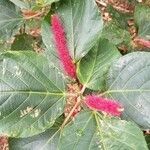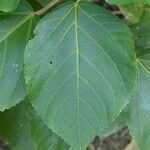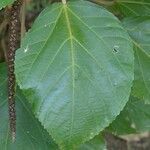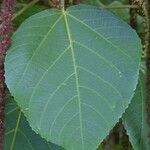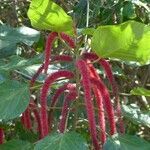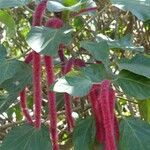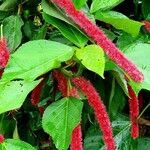Shrubs, 1-3 m tall. Branchlets grayish tomentulose when young. Stipules triangular, 6-10 mm, pilose; petiole 4-8 cm; leaf blade broadly ovate or ovate, 8-20 × 5-14 cm, papyraceous, base broadly cuneate, obtuse, or subcordate, margin coarsely serrate, apex acuminate or acute; basal veins 3-5. Plants dioecious. Only female flowers known. Female flowers 3-7 in each bract, fascicled, subsessile; spikes 15-30 cm, axillary, pendulous; peduncle short, pubescent; bracts scattered, ovate-rhombic, ca. 1 mm, entire; sepals (3 or)4, subovate, ca. 1 mm, acute, puberulent; ovary subglobose, densely hirtellous; styles 3, 5-7 mm, laciniate, crimson or red-purple. Fl. Feb-Nov.
A shrub. It has soft stems. It grows 1.8-3.5 m tall. It spreads 1.5 m wide. The leaves are large and broadly oval. They are 15 cm long. They are bright green to reddish bronze. They have long leaf stalks. The edges of the leaves are toothed. The leaves are covered with fine hairs. The flowers are bright red and hang down. They have red stamens and look like furry, red cat's tails.
Petioles up to 15 cm long; leaf blades up to 20 × 15 cm, broadly ovate or rhombic-ovate, shortly acuminate at the apex, serrate on the margins, rounded or cuneate at the base, 5–7-nerved from the base, thinly chartaceous, sparingly pubescent to subglabrous on both surfaces, more evenly pubescent along the midrib and main veins; lateral nerves in 6–9 pairs.
Female inflorescences up to 30 cm long, spicate, axillary, solitary, dense-flowered, bright red on account of the masses of styles; axis sparingly pubescent; female bracts minute, ovate, acute, entire, not accrescent.
Female flowers sessile; sepals 3–4, 0.7 mm long, triangular-ovate, acute, ciliate; ovary 1 mm in diameter, 3-lobed to subglobose, densely pubescent; styles 5–7 mm long, ± free to the base, laciniate, bright red.
Young shoots and petioles tomentose, later sparingly puberulous or glabrescent.
Stipules 6–7 mm long, lanceolate, sparingly pubescent, brown.
A much-branched shrub up to 2 m tall, dioecious.
Mature fruit and seeds not known.
Male inflorescences unknown.
